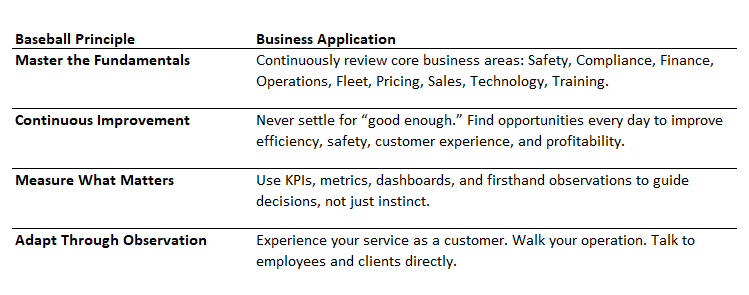Championship Mindset: How Fundamentals and Metrics Build Business Success
Lessons from a Little League field on mastering the basics, leading with purpose, and building high-performing teams.

Some of the most valuable leadership lessons I’ve learned didn’t come from a boardroom or a business textbook—they came from a Little League field in Altamonte Springs, Florida.
Coaching the 2013 AAA-National Braves, with my son on the team, taught me two principles that shaped how I lead today:
- Always maintain a continuous improvement mindset.
- If you can measure it, you can manage it.
These lessons helped turn an underdog team into champions — and they’re just as powerful for business leadership today.
Building a Team from Scratch
That spring, my son and I attended tryouts simply to participate. Coaching wasn’t even on my radar. But when the league president approached me and asked me to step up after another parent withdrew, I agreed, despite having no experience as a head coach.
We quickly assembled a team, tapping into a few willing parents to help. We had talent, heart, and enthusiasm—but little structure, cohesion, or experience working together.
We resembled a startup organization in many ways: plenty of potential, but raw and untested.
Our first two games were brutal. We faced the best team in the league—the Marlins—and lost badly both times.
Those losses hurt, but they revealed something critical: raw talent isn’t enough. Systems, fundamentals, and mindset matter.
Leading Through Fundamentals and Metrics
Rather than get discouraged, we doubled down on two principles:
1. Continuous Improvement
Every practice session was split into two parts:
Fundamentals: hitting, fielding, base running, stealing bases, pitching basics.
Game Simulations: real-world scenarios—executing double plays, throwing out runners at home, tracking balls in the outfield.
We started with the basics each week and built from there, ensuring players developed confidence in core skills before adding complexity.
This mirrored my business philosophy: master the basics before scaling complexity.
2. Measure to Manage
We also kept track of performance data from day one—hitting percentages, fielding success, pitching effectiveness.
By analyzing the numbers and blending them with firsthand observations, we:
Built smarter lineups.
Optimized pitcher rotations.
Ensured every player contributed meaningfully.
We didn’t just hope improvement would happen—we created a framework where it could be seen, measured, and acted on.
Turning the Tide
At the season’s midpoint, we faced the Marlins again. While we lost by just one run this time, the message was clear: the gap was closing.
Our practices began to pay off:
- Players anticipated plays instead of reacting late.
- Pitchers attacked the strike zone with more confidence.
- Fielders communicated and executed under pressure.
In our final regular-season matchup with the Marlins, we fought to a dramatic 19-19 tie—a psychological breakthrough that changed everything.
The team realized: We can play with anyone.
From that moment on, we never looked back. We won our next two games convincingly, entered the playoffs as the #2 seed, and eventually faced the Marlins for the championship.
On that final day, everything came together—defense, pitching, and hitting.
We won 11-4, completing a journey that began with two blowout losses and ended with a trophy in our hands.
It wasn’t just a win; it validated the potential of consistent fundamentals, continuous improvement, and data-driven adjustments.
Business Leadership Parallels
The same principles that carried a group of nine-year-olds to a championship apply directly to business leadership, especially in industries like ground transportation.
Here’s how:
In baseball and business, there are no shortcuts. Success is earned through preparation, discipline, adaptability, and measurement.

Checklist: Key Fundamentals for Transportation Companies
Use this checklist to guide continuous improvement and ensure you’re managing what matters most:
- Safety and Compliance: DOT adherence, driver qualifications, vehicle inspections.
- Accounting and Finance: Accurate revenue, expenses, and profitability tracking.
- Customer Experience and Operations: Regular audits of service delivery and operational processes.
- Fleet Management: Preventive maintenance, vehicle lifecycle management, cleanliness standards.
- Pricing Strategy: Ensuring profitability and adjusting for market and cost conditions.
- Sales and Marketing: Targeting the right market segments with aligned messaging.
- Technology Optimization: Leveraging technology to reduce costs and enhance service.
- Training and Development: Keeping employee skills sharp and aligned with real-world challenges.
Continuous improvement means embedding this checklist into your routine—not just reviewing it annually, but living it daily.
Final Thoughts
Championships, whether in baseball or business, aren’t the result of one great play or one big decision.
They result from hundreds of small, disciplined actions—mastering fundamentals, improving consistently, measuring relentlessly, and adapting with humility and focus.
The same principles that turn a young baseball team into champions can make your company a market leader.
When you lead with fundamentals and measure what matters, you won’t just compete—you’ll win.

Brian Dickson is the owner of Bus Business Consultants and author of Ground Transportation Insights on Substack. Drawing on leadership roles in motorcoach operations and Disney’s Guest Transportation, he helps operators improve performance, culture, and growth—Bus Business Consultants: Driving Performance, Culture, & Growth in Ground Transportation.
This article was originally published on April 16, 2025 at Ground Transportation Insights.
The views expressed are those of the author alone and do not necessarily reflect the position of the American Bus Association.

